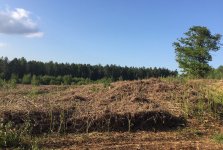-
Welcome to BirdForum, the internet's largest birding community with thousands of members from all over the world. The forums are dedicated to wild birds, birding, binoculars and equipment and all that goes with it.
Please register for an account to take part in the discussions in the forum, post your pictures in the gallery and more.
You are using an out of date browser. It may not display this or other websites correctly.
You should upgrade or use an alternative browser.
You should upgrade or use an alternative browser.
Norfolk birding (20 Viewers)
- Thread starter Edward woodwood
- Start date
More options
Who Replied?Farnboro John
Well-known member
(I posted links on another East Anglican thread)
Hoping for divine inspiration?
John
Hoping for divine inspiration?
John
Shelducks
Driving towards Rackheath from the roundabout near Beeston farm shop the first pool on the left normally holds 2 Shelducks.
Which pool? I drive the length of it a fair bit and have been looking out for them to no avail .
Driving towards Rackheath from the roundabout near Beeston farm shop the first pool on the left normally holds 2 Shelducks.
Deb Burhinus
Used to be well known! 😎

Hoping for divine inspiration?
John
Came in the form of several Woodlarks singing on territority and the pinging contact call of a nightingale when I took the dog for a walk earlier - ah, the joy of sunny spring evenings in Thetford Forest
Last edited:
Deb Burhinus
Used to be well known! 😎

Deb Burhinus
Used to be well known! 😎

Lots! Some good views too. RSPB Lakenheath is a reliable shout.
On my forest patch this evening at least 3 roding Woodcock, a couple of Hobbys hawking long after the sun went down, Tree Pipit singing from the Yellow Hammer’s tree and enough mossie bite to empty a blood bank.
On my forest patch this evening at least 3 roding Woodcock, a couple of Hobbys hawking long after the sun went down, Tree Pipit singing from the Yellow Hammer’s tree and enough mossie bite to empty a blood bank.
mark clements
New member
Anyone heard a Cuckoo at all this year ?
None at all, in mid-Norfolk, Harry
Deb Burhinus
Used to be well known! 😎

Don’t know if anyone is watching the satellite weather but a pretty intense band of rain/storms is heading right for the East coast of Norfolk moving at the moment NNW. If it doesnt break up before landfall or get pushed out over the North Sea, we could get some flash floods over the broads and round the coast to minsmere.
Richard TheSlovakBirder
Member
Hello guys, please, is the Weeting Heath still the best place to see Stone Curlews in Norfolk? Thanks in advance.
Last edited:
James Emerson
Norwich Birder
Hi Richard.
Weeting Heath is good for Stone Curlews in spring and early summer, but around now they are probably beginning to move away and gathering elsewhere prior to migration. I would advise calling the visitors centre to check before visiting in case they have gone - details here: https://www.norfolkwildlifetrust.org.uk/wildlife-in-norfolk/nature-reserves/reserves/weeting-heath
Regards,
James
Weeting Heath is good for Stone Curlews in spring and early summer, but around now they are probably beginning to move away and gathering elsewhere prior to migration. I would advise calling the visitors centre to check before visiting in case they have gone - details here: https://www.norfolkwildlifetrust.org.uk/wildlife-in-norfolk/nature-reserves/reserves/weeting-heath
Regards,
James
Hello guys, please, is the Weeting Heath still the best place to see Stone Curlews in Norfolk? Thanks in advance.
Richard TheSlovakBirder
Member
Hi Richard.
Weeting Heath is good for Stone Curlews in spring and early summer, but around now they are probably beginning to move away and gathering elsewhere prior to migration. I would advise calling the visitors centre to check before visiting in case they have gone - details here: https://www.norfolkwildlifetrust.org.uk/wildlife-in-norfolk/nature-reserves/reserves/weeting-heath
Regards,
James
Thanks you, James, we have tried Covenham Heath, but without aby success...
Farnboro John
Well-known member
Thanks you, James, we have tried Covenham Heath, but without aby success...
The warden and the elderly sidekick volunteer who is annual at the site have advised me in the past that August is a good time to get good views of Stone Curlew at Weeting as an initial post-breeding gathering occurs there, but of course I accept no liability for this year's performance...
John
Yep. Also, a Great Skua was on the beach at Salthouse for a few days. Also, there was almost daily sightings of Black Terns included one by me (a lifer for me). Strange sighting when I was there was two Dunlin which were extremely tame or exhausted. They sat in a dyke whilst I was walking past just a few meters away. I was on the path East of the East Bank if anyone knows where I mean.
A question from a visiting North Easterner: on Friday afternoon (14th September) we were driving east along the A148 near Harpley when I spotted a red kite sailing along, heading west above the road.
How usual is it to find red kites in north Norfolk? It's not something I associate with this part of the world.
Oh, if the black terns are still around at Salthouse they hid from us today.
How usual is it to find red kites in north Norfolk? It's not something I associate with this part of the world.
Oh, if the black terns are still around at Salthouse they hid from us today.
Users who are viewing this thread
Total: 21 (members: 0, guests: 21)





